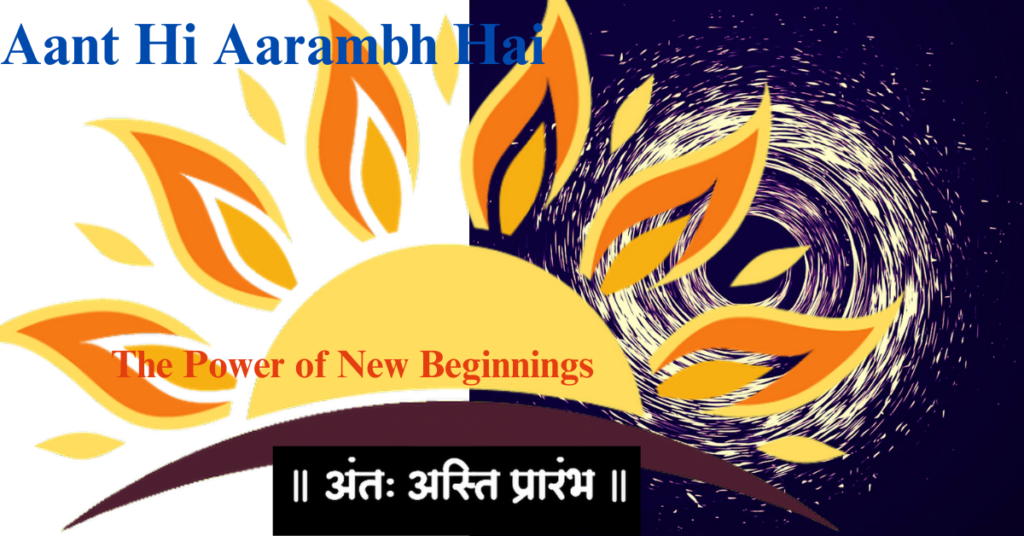
Table of Contents
“Aant Hi Aarambh Hai: The Power of New Beginnings”
Introduction
“Aant Hi Aarambh Hai,” a Hindi phrase translating to “The End is the Beginning,” captures a deep truth about the cyclical nature of life. This concept suggests that every conclusion brings with it the seed (step) of a new begining, a belief resonating deeply in various cultures, philosophies, and personal experiences. In this article we tells about the various dimensions of this”Aant Hi Aarambh Hai,”, exploring its implications in nature, human life, and cultural narratives.
The Cycle of Nature”Aant Hi Aarambh Hai: The Power of New Beginnings”
Nature itself offers the most evident illustration of the cyclical nature of existence. The changing seasons, the life cycle of plants and animals, and the water cycle all embody the principle that endings are intrinsically linked to new beginnings.
- Seasons: The transition from winter to spring symbolizes how the death of one season leads to the birth of another. Winter, often perceived as a time of dormancy and stillness, is essential for the rejuvenation that spring brings. Without winter’s rest and the subsequent thaw, the blooming of flowers and the rebirth of nature in spring would not occur.
- Life and Death: The life cycle of plants and animals further exemplifies this principle. When a plant dies, it decomposes and returns nutrients to the soil, which in turn nourish new plant life. Similarly, in ecosystems, the death of one organism can support the life of another, maintaining the balance and continuity of life.
- Water Cycle: The continuous movement of water on, above, and below the surface of the Earth shows how endings lead to beginnings. Water evaporates, forms clouds, and returns to the earth as precipitation, a never-ending cycle that sustains life.
Human Life and Personal Growth
Human experiences are replete with instances where endings pave the way for new beginnings. From personal losses to career changes, every conclusion we face often holds the potential for new opportunities and growth.
- Personal Losses: The end of relationships, whether through separation or death, can be incredibly painful. However, these endings often become turning points, forcing individuals to rediscover themselves, explore new paths, and build resilience. The grief process, although difficult, can lead to personal growth and new beginnings.
- Career Transitions: Professional life is full of transitions. Losing a job or deciding to switch careers can be daunting, but it often leads to exploring new passions, acquiring new skills, and discovering previously unexplored opportunities. Many people find that these challenging periods ultimately lead to greater fulfillment and success in their professional lives.
- Education: Graduation marks the end of a significant chapter in a person’s life but also signifies the beginning of another. Leaving the familiar environment of school or college can be unsettling, yet it opens up a world of possibilities in higher education, careers, and personal development.
Cultural and Philosophical Perspectives
The concept of “Aant Hi Aarambh Hai” is deeply embedded in various cultural narratives and philosophical teachings. These perspectives highlight how endings and beginnings are interwoven and essential to the human experience.
- Eastern Philosophies: In Hinduism and Buddhism, the concept of cyclic existence, or samsara, is central. Life, death, and rebirth are seen as a continuous cycle, where each end is a new beginning. This belief encourages individuals to view endings not with fear but with acceptance and readiness for the new phase that follows.
- Western Philosophies: Western philosophies also acknowledge this cyclical nature. The Greek philosopher Heraclitus famously stated, “The only constant in life is change.” This recognition of the inevitability of change underlines the importance of embracing both endings and beginnings as integral parts of life.
- Literature and Art: Literature and art frequently explore themes of endings and new beginnings. From classic literature like “The Great Gatsby” to contemporary films like “The Shawshank Redemption,” these narratives reflect the transformative power of endings. Art often depicts cycles of life, death, and rebirth, emphasizing the continuity and renewal inherent in existence.
Case Studies and Real-Life Examples
Examining real-life examples and case studies can further illuminate the principle of “Aant Hi Aarambh Hai.”
- Steve Jobs: Steve Jobs, co-founder of Apple Inc., experienced a significant ending when he was ousted from the company he helped create. This setback, however, became a new beginning. Jobs founded NeXT and acquired Pixar, leading to groundbreaking developments in technology and animation. His return to Apple marked the beginning of a new era of innovation and success for the company.
- Malala Yousafzai: Malala Yousafzai’s life offers another powerful example. After surviving a near-fatal attack by the Taliban, Malala’s ordeal marked the end of her childhood and the beginning of her journey as a global advocate for girls’ education. Her experience underscores how a traumatic ending can lead to a new purpose and impactful beginnings.
- Natural Disasters: Communities often face devastating endings due to natural disasters. Yet, these tragedies also prompt new beginnings as people come together to rebuild, innovate, and create more resilient societies. The rebuilding process fosters community spirit, innovation, and a renewed commitment to better future preparedness.
Psychological Insights
From a psychological perspective, how individuals cope with endings and embrace new beginnings is crucial for mental health and personal development.
- Resilience: The ability to bounce back from adversity is a key aspect of resilience. People who view endings as opportunities for new beginnings tend to exhibit greater resilience. This mindset helps them navigate life’s challenges more effectively and emerge stronger from difficult experiences.
- Growth Mindset: Carol Dweck’s concept of a growth mindset is relevant here. Individuals with a growth mindset see challenges and setbacks as opportunities to learn and grow. They understand that failure or the end of one endeavor can lead to the beginning of another, often more fruitful, journey.
- Acceptance and Mindfulness: Practices such as mindfulness and acceptance can help individuals navigate the transitions between endings and beginnings. Mindfulness encourages staying present and accepting the current moment, which can ease the anxiety associated with change and foster a more positive outlook on new beginnings.
Conclusion
“Aant Hi Aarambh Hai” encapsulates a universal truth that transcends cultural, natural, and individual boundaries. Endings, while often challenging, are not just conclusions but the starting points for new journeys. Whether in the natural world, personal lives, cultural narratives, or psychological frameworks, the interconnection between endings and beginnings is a testament to the resilience and continuity of life. Embracing this principle can lead to a more fulfilling and optimistic approach to the inevitable changes we all encounter, fostering growth, renewal, and a deeper understanding of the cyclical nature of existence.”Aant Hi Aarambh Hai: The Power of New Beginnings” this is a ultimate truth of span of life of every living things in this planet.


